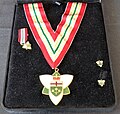Official symbols
Several emblems and symbols are used to officially represent the province, established through royal warrant or through the Legislative Assembly of Ontario. They include: [1] [2]
| Symbol | Image | Adopted | Notes | |
|---|---|---|---|---|
| Coat of arms | Coat of arms of Ontario |  | May 26, 1868, augmented on February 27, 1909 [2] | The present coat of arms was adopted on February 27, 1909, by royal warrant of King Edward VII. The design builds upon the original shield of arms granted by royal warrant of Queen Victoria on May 26, 1868, with the addition of supporters, crest, and motto. [3] |
| Shield of arms | Shield of arms of Ontario |  | May 26, 1868 [2] | The shield of arms was granted by royal warrant of Queen Victoria. The shield of arms is used on the current-arms escutcheon. [3] Gold maple leaves were adopted on the shield of arms as it historically represented Ontario (whereas green maple leaves represented Quebec). [4] |
| Motto | Ut incepit fidelis sic permanet (English: Loyal she began, loyal she remains) | 1909 | The motto is a reference to the United Empire Loyalists, and was granted with other elements of the coat of arms in 1909. [2] The motto is in Latin, and may also be translated as "Loyal she began, thus she remains". | |
| Flag | Flag of Ontario |  | April 14, 1965 [5] | It is a defaced Red Ensign, with the Royal Union Flag in the canton and the Ontario shield of arms in the fly. Queen Elizabeth II approving the use of the Royal Union Flag in the design and the flag was adopted by the Legislative Assembly of Ontario in 1965. [2] The flag was approved by the legislature on April 14, 1965, and was first raised on May 21, 1965. [5] |
| Flower | White trillium Trillium grandiflorum |  | 1937 [2] | Adopted as the province's official floral emblem through the Floral Emblem Act, 1937. [6] The adoption of the white trillium grew out of a movement during the First World War to choose a national floral emblem appropriate for planting on the graves of Canadian servicemen overseas. Found in the forests and woodlands of Ontario, it blooms in late April and May. They are very sensitive to light and usually bend toward the sun as it moves across the sky. Contrary to popular belief, it is not illegal to pick a White Trillium in Ontario. However, picking the flower can seriously injure the plant and it can take years to recover. [2] |
| Bird | Common loon Gavia immer |  | June 23, 1994 [2] | The common loon was designated as an official emblem of the province through the Avian Emblem Act, 1994. [7] The common loon is found across the province. The image of a common loon is also displayed on the Canadian one-dollar coin, commonly called a "loonie". [2] |
| Colours | Green and yellow [2] or green and gold [8] [9] | |||
| Francophone flag | Franco-Ontarian flag |  | September 24, 2020 [10] | Recognized under provincial law as an emblem of the province of Ontario, as well as Franco-Ontarians. The flag was adopted as an official emblem of Ontario in 2020 by the Legislative Assembly of Ontario, through an amendment to the Franco-Ontarian Emblem Act. The flag was initially adopted as an emblem for Franco-Ontarians through the Franco-Ontarian Emblem Act on June 29, 2001. [1] [11] |
| Gemstone | Amethyst |  | July 7, 1975 [12] | Established as an official emblem of the province through the Mineral Emblem Act, 1975. [12] Amethyst was adopted in order to represent the mineral wealth of the province. Amethyst can be found in clusters throughout northern Ontario, concentrating around the area of Thunder Bay. [2] |
| Tartan | Red and white with three shades of green and two shades of blue | June 23, 2000 [13] | The tartan was created in 1965 by Rotex Ltd., although was not formally adopted as the provincial tartan until the Tartan Act, 2000 was passed. [13] [14] The tartan is made up of four blocks of colour, red, white, three shades of green and two shades of blue. The shades of green represent the forests and fields of Ontario, while the blue represents the waters. The red represents its First Nations and the white, the sky over the province. [2] | |
| Tree | Eastern white pine Pinus strobus |  | May 1, 1984 [2] | The eastern white pine was adopted as an official emblem of the province through the Arboreal Emblem Act, 1984. [15] The tree species is found throughout Ontario. It is the tallest tree in the province and can live over 250 years. Known as "the Tree of Great Peace" by the Haudenosaunee First Nations of Southern Ontario. The eastern white pine was also an important source of income and trade during the province's early days. [2] |






